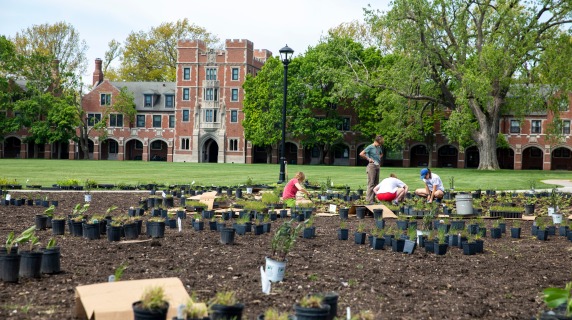< MacEachron Field Geothermal Field
Prairie and Sustainability
Bear Athletic Center >

Prairie
The tallgrass prairie, which was once common in Iowa, is extremely rare today. It features rich, moist, well-drained soils with level or gently rolling landscapes. Big bluestem and other grasses dominate the prairie. Today, the prairie is often human-stewarded; this diverse, fire-maintained ecosystem features deep-rooted native grasses, forbs, and associated life forms above ground and in the soil.
Prairies build soil, reduce and filter water runoff, and provide habitat for pollinators and many other creatures. It is also resilient to extreme weather, disease, and predation.

Environmental Sustainability
The environmental sustainability of the prairie begins at its roots. The long root systems of native prairie grasses allow for a greater rate of water infiltration, which minimizes flooding, reduces runoff, and decreases soil erosion.
Grinnell College has made substantial efforts to reduce runoff, including the establishment of rainwater collection systems in the Noyce Science Center, the Bear Recreation and Athletic Center, and the Humanities and Social Studies Center.
The implementation of native tallgrass prairies into our landscape will naturally increase infiltration and reduce the silt and nutrient loads that the College sends downstream. The native grasses’ long root systems also allow the plants to recover nutrients from the soil that would otherwise be lost or leached into groundwater (Atkin, 2006).

Social Sustainability
Grinnell’s native landscaping also supports social sustainability through community engagement.
The Grinnell College campus has great potential to promote community well-being. With this in mind, Grinnell continues to implement more prairie plantings on campus.
Prairie plantings create relationships that actively support the creation of healthy and livable communities for current and future generations, thus encouraging social sustainability. The MacEachron Field prairie planting was a great opportunity for volunteers and student workers to work together on a project that will benefit all.

Economic Sustainability
Increasing native prairie plantings on campus creates more job opportunities for the student body and encourages economic sustainability.
The native landscape naturally attracts community members and students, encouraging their involvement in campus infrastructure over time and promoting long-term economic growth.
Grinnell’s prairie plantings on campus help create a future in which the use of natural resources is sustainable, while also creating a community of individuals committed to contributing to the common good.
Conard Environmental Research Area
CERA’s mission is to preserve and, through restoration, recreate a part of Iowa’s vanishing natural heritage, providing a resource for the entire community, including the College, local schools, environmental groups, clubs, and the general public. It has also provided seed mixes and Iowa native prairie plugs for some of the landscaping on campus.





